Class 10 SELINA Solutions Maths Chapter 18 - Tangents and Intersecting Chords
Tangents and Intersecting Chords Exercise Test Yourself
Solution 1(f)
Correct option: (iv) A is false, R is false
It is not given that whether the circles are touching, intersecting or non-intersecting.
So, the assertion is false.
Also, the reason is false.
∗∗In the book, the answer is given as option (iii) which is incorrect.∗∗
Solution 1(e)
Correct option: (iv) 2R units
Let the tangents be drawn to the circle at points A and B and they intersect each other at point P.
Let O be the centre of the circle.
Now, OA ⊥ AP and OB ⊥ BP … (Since, tangent ⊥ radius)
In ΔOAB, ∠AOB = 90° … (Since, OAPB is a square)
⇒ AB2 = OA2 + OB2 = 2R2 + 2R2 = 4R2
⇒ AB = 2R units
Thus, the shortest distance between the two points of contact is 2R units.
Solution 1(d)
Correct option: (iv) 42°
Since, OA = OD … (Radii of the same circle)
⇒∠OAD = ∠ODA
But ∠OAD + ∠ODA + ∠AOD = 180°
⇒∠OAD = ∠ODA = 48°
Also, ∠OAQ = 90° … (Tangent ⊥ radius)
⇒∠QAD = 90°–∠OAD = 42°
Solution 1(c)
Correct option: (iii) 35°
In ΔOAB,
∠OAB = 90° … (Tangent ⊥ radius)
⇒∠AOC = 70°
In ΔOAC, OA = OC
⇒∠OCA = ∠OAC
Now, ∠OAC + ∠AOC + ∠OCA = 180°
⇒∠OAC = ∠OCA = 55°
But, ∠BAC = ∠OAB –∠OAC = 35°
Solution 1(b)
Correct option: (iv) 90° – x
Since, OA = OB … (Radii of the same circle)
⇒∠OAB = ∠OBA
⇒∠OBA = x
Also, ∠OBP = 90° … (Tangent ⊥ radius)
⇒∠ABP = 90°– x
Solution 1(a)
Correct option: (iii) 12 cm
AC = AB + BC = 18 cm
Since, AC and AP intersect externally.
⇒ AB × AC = AP2
⇒ AP2 = 8 × 18 = 144 cm2
⇒ AP = 12 cm
Tangents and Intersecting Chords Exercise Ex. 18(A)
Solution 2
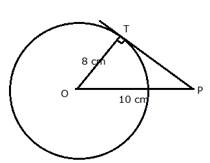
OP = 10 cm; radius OT = 8 cm

Length of tangent = 6 cm.
Solution 3
AB = 15 cm, AC = 7.5 cm
Let 'r' be the radius of the circle.
![]() OC = OB = r
OC = OB = r
AO = AC + OC = 7.5 + r
In ∆AOB,
AO2 = AB2 + OB2

Therefore, the length of radius of a circle is 11.25 cm.
Solution 4
From Q, QA and QP are two tangents to the circle with centre O.
Therefore, QA = QP .....(i)
Similarly, from Q, QB and QP are two tangents to the circle with centre O'.
Therefore, QB = QP ......(ii)
From (i) and (ii)
QA = QB
Therefore, tangents QA and QB are equal.
Solution 5

Radius of outer circle, OS = 5 cm.
Radius of inner circle, OT = 3 cm.
 (Angle between the radius and the tangent)
(Angle between the radius and the tangent)
In Rt. triangle OTS, by Pythagoras Theorem,

Since OT is perpendicular to SP and OT bisects chord SP,
SP = 8 cm
Solution 6
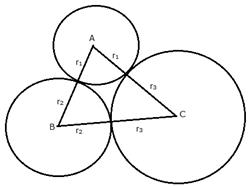
AB = 6 cm, AC = 8 cm and BC = 9 cm
Let radii of the circles having centers A, B and C be r1, r2 and r3 respectively.
r1 + r3 = 8 ....(1)
r3 + r2 = 9 ....(2)
r2 + r1 = 6 ....(3)
Adding (1), (2) and (3),
r1 + r3 + r3 + r2 + r2 + r1 = 8 + 9 + 6
2(r1 + r2 + r3) = 23
r1 + r2 + r3 = 11.5 cm
r1 + 9 = 11.5 (Since r2 + r3 = 9)
r1 = 2.5 cm
r2 + 8 = 11.5 (Since r1 + r3 = 8)
r2 = 3.5 cm
r3 + 6 = 11.5 (Since r1 + r2 = 6)
r3 = 5.5 cm
Hence, r1 = 2.5 cm, r2 = 3.5 cm and r3 = 5.5 cm
Solution 7
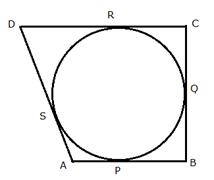
Let the circle touch the sides AB, BC, CD and DA of quadrilateral ABCD at P, Q, R and S respectively.
Since AP and AS are tangents to the circle from external point A,
AP = AS ....(i)
Similarly, we can prove that:
BP = BQ ....(ii)
CR = CQ ....(iii)
DR = DS ....(iv)
Adding (i), (ii), (iii) and (iv),
AP + BP + CR + DR = AS + DS + BQ + CQ
AB + CD = AD + BC
Hence, AB + CD = AD + BC
Solution 8
From A, AP and AS are tangents to the circle.
Therefore, AP = AS ....(i)
Similarly, we can prove that
BP = BQ ....(ii)
CR = CQ ....(iii)
DR = DS ....(iv)
Adding,
AP + BP + CR + DR = AS + DS + BQ + CQ
AB + CD = AD + BC
But AB = CD and BC = AD ....(v) [Opposite sides of a parallelogram]
Therefore, AB + AB = BC + BC
2AB = 2BC
AB = BC ....(vi)
From (v) and (vi)
AB = BC = CD = DA
Hence, ABCD is a rhombus.
Solution 9
From B, BQ and BP are the tangents to the circle.
Therefore, BQ = BP ....(i)
Similarly, we can prove that
AP = AR ....(ii)
and CR = CQ ....(iii)
Adding,
AP + BQ + CR = BP + CQ + AR ....(iv) [Proved]
Adding (AP + BQ + CR) to both sides,
2(AP + BQ + CR) = AP + BP + CQ + BQ + AR + CR
2(AP + BQ + CR) = AB + BC + CA
Therefore, AP + BQ + CR = ![]() x (AB + BC + CA)
x (AB + BC + CA)
AP + BQ + CR = ![]() x Perimeter of triangle ABC
x Perimeter of triangle ABC
Solution 10
From A, AP and AR are the tangents to the circle.
Therefore, AP = AR.
Similarly, we can prove that
BP = BQ and CR = CQ
Adding,
AP + BP + CQ = AR + BQ + CR
(AP + BP) + CQ = (AR + CR) + BQ
AB + CQ = AC + BQ
But AB = AC
Therefore, BQ = CQ
Solution 11
Radius of bigger circle = 6.3 cm
Radius of smaller circle = 3.6 cm
i)
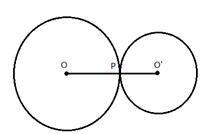
Two circles are touching each other at P externally.
O and O’ are the centers of the circles.
Join OP and O’P
OP = 6.3 cm, O’P = 3.6 cm
Distance between the centres = OO'
= OP + O’P
= 6.3 + 3.6
= 9.9 cm
ii)
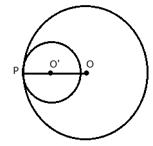
Two circles are touching each other at P internally.
O and O’ are the centers of the circles.
Join OP and O’P.
OP = 6.3 cm, O’P = 3.6 cm
Distance between the centres = OO’
= OP - O’P
= 6.3 - 3.6
= 2.7 cm
Solution 12
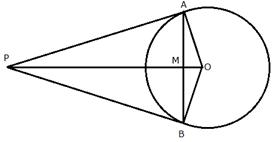
i) In ![]()
AP = BP (Tangents from P to the circle)
OP = OP (Common)
OA = OB (Radii of the same circle)

ii) In ![]()
OA = OB (Radii of the same circle)
![]() (Proved
(Proved ![]() )
)
OM = OM (Common)

Hence, OM or OP is the perpendicular bisector of chord AB.
Solution 13
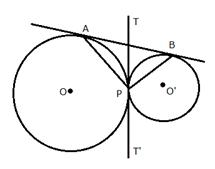
Draw TPT' as common tangent to the circles.
i) TA and TP are the tangents to the circle with centre O.
Therefore, TA = TP ....(i)
Similarly, TP = TB ....(ii)
From (i) and (ii)
TA = TB
Therefore, TPT' is the bisector of AB.
ii) Now in ![]()
![]()
Similarly in ![]()
![]()
Adding,

Solution 14
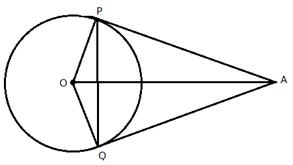
In quadrilateral OPAQ,

Now,

In triangle OPQ,
OP = OQ (Radii of the same circle)

From (i) and (ii)
![]()
Solution 15

In ![]()

Therefore, LBMO is a square.
LB = BM = OM = OL = x
![]()
Since ABC is a right triangle

Solution 16
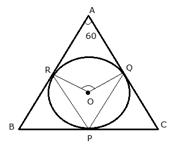
The incircle touches the sides of the triangle ABC and
![]()
i) In quadrilateral AROQ,

ii) Now arc RQ subtends ![]() at the centre and
at the centre and ![]() at the remaining part of the circle.
at the remaining part of the circle.

Solution 17
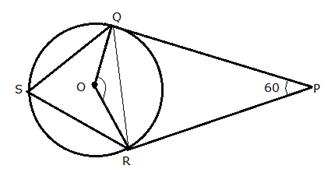
Join QR.
i) In quadrilateral ORPQ,

![]()
ii) In ![]()
OQ = QR (Radii of the same circle)

iii) Now arc RQ subtends ![]() at the centre and
at the centre and ![]() at the remaining part of the circle.
at the remaining part of the circle.

Solution 18
In ![]()
OB = OC (Radii of the same circle)

Now in ![]()

Solution 19
 (angles in alternate segment)
(angles in alternate segment)
But OS = OR (Radii of the same circle)

Now,
OQ = OR (radii of same circle)

But in ![]()

From (i) and (ii),

Solution 20
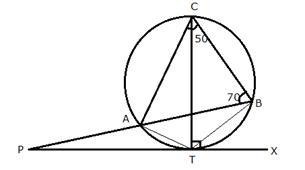
Join AT and BT.
i) TC is the diameter of the circle
![]() (Angle in a semi-circle)
(Angle in a semi-circle)
ii) ![]()
![]() (Angles in the same segment of the circle)
(Angles in the same segment of the circle)
![]()
![]() (Angles in the same segment of the circle)
(Angles in the same segment of the circle)
![]()
iii) ![]() (angle between a tangent and a chord through the point of contact is equal to an angle in the alternate segment)
(angle between a tangent and a chord through the point of contact is equal to an angle in the alternate segment)
![]()
Now in ![]()

Solution 21

Join OC.
Now, PA and PC are the tangents to the circle with centre O.
![]()
In quadrilateral APCO,


Now, arc BC subtends ![]() at the centre and
at the centre and ![]() at the remaining part of the circle
at the remaining part of the circle

Solution 22
∠CAB = ∠BAQ = 30° (AB is angle bisector of ∠CAQ)
Then, ∠CAQ = 2∠BAQ = 60°
Now, ∠CAQ + ∠PAC = 180° (angles in linear pair)
∴ ∠PAC = 180° - 60° = 120°
∠PAC = 2∠CAD (AD is angle bisector of ∠PAC)
∠CAD = 60°
Now,
∠DAB = ∠CAD + ∠CAB = 60° + 30° = 90°
Thus, BD subtends a right angle on the circle.
So, BD is the diameter of the circle.
Solution 1(a)
Correct option: (i) 9 cm
Let the tangent QR touches the circle at point S.
Tangents from an external point to the circle are equal to each other.
⇒ PA = PB, RA = RS and QB = QS
Now, PQ + QR + PR = 18 cm
⇒ PQ + QS + SR + PR = 18 cm
⇒ PQ + QB + RA + PR = 18 cm
⇒ PB + PA = 18 cm
⇒ PA = PB = 9 cm
Solution 1(b)
Correct option: (i) 16 cm
OP ⊥ AB … (Tangent at any point and the radius through this point are perpendicular)
In ΔOAP, ∠OPA = 90°
⇒ OA2 = OP2 + AP2
⇒ AP = 8 cm
Since, perpendicular drawn from the centre of a circle to the chord bisects the chord.
⇒ AB = 2AP = 16 cm
Solution 1(c)
Correct option: (ii) 17 cm
Given: AC = 15 cm, BC = 8 cm
In ΔABC, ∠ACB = 90°
⇒ AB2 = AC2 + BC2
⇒ AB2 = 225 + 64 = 289 cm2
⇒ AB = 17 cm
So, P will equidistant from the vertices of the side AB.
⇒ PA = PB
Solution 1(d)
Correct option: (iii) 40°
∠DOC + ∠DOA = 180°
⇒∠DOA = 80°
In ΔAOD, OA = OD … Radii of same circle
⇒∠ADO = ∠DAO
Now, ∠ADO + ∠DOA + ∠OAD = 180°
⇒ 2∠ADO = 100°
⇒∠ADO = ∠DAO = 50°
⇒∠ODB = 180°–∠ADO = 130°
Thus, ∠B = 360°–∠BDO –∠DOC –∠OCD = 40°
Solution 1(e)
Correct option: (iv) 55°
Here, ∠OAP = 90° = ∠OBP … Tangent ⊥ Radius
In quadrilateral OAPB,
∠AOB = 360°–∠OAP –∠OBP –∠APB = 110°
Angle subtended by an arc at the centre is twice the angle subtended by the same arc at the remaining circumference.
⇒∠ACB = ½∠AOB = 55°
Tangents and Intersecting Chords Exercise Ex. 18(B)
Solution 2

Solution 3
i) PAQ is a tangent and AB is the chord.
![]() (angles in the alternate segment)
(angles in the alternate segment)
ii) OA = OD (radii of the same circle)

iii) BD is the diameter.
![]() (angle in a semi-circle)
(angle in a semi-circle)
Now in ![]()

Solution 4
PQ is a tangent and OR is the radius.

But in ![]()
OT = OR (Radii of the same circle)

In ![]()

Solution 5
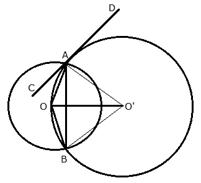
Join O'A and O'B.
CD is the tangent and AO is the chord.
![]() (angles in alternate segment)
(angles in alternate segment)
In ![]()
OA = OB (Radii of the same circle)
![]()
From (i) and (ii)
![]()
Therefore, OA is bisector of ![]() BAC.
BAC.
Solution 6
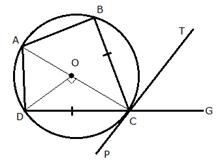
Join OC, OD and OA.
i)

ii)
PCT is a tangent and CA is a chord.
![]()
But arc DC subtends ![]() at the centre and
at the centre and ![]() at the
at the
remaining part of the circle.
![]()
Solution 7
i) PA is the tangent and AB is a chord
![]() ( angles in the alternate segment)
( angles in the alternate segment)
AD is the bisector of ![]()
![]()
In ![]()
![]()
Therefore, ![]() is an isosceles triangle.
is an isosceles triangle.
ii) In ![]()

Solution 8
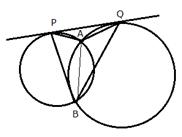
Join AB.
 (angles in alternate segment)
(angles in alternate segment)
Similarly,

Adding (i) and (ii),

From (iii) and (iv)

Hence, ![]() and
and ![]() are supplementary.
are supplementary.
Solution 9
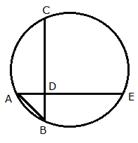
Join AB.
i) In Rt. ![]()

Chords AE and CB intersect each other at D inside the circle.
Therefore,
AD x DE = BD x DC
3 x DE = 4 x 9
DE = 12 cm
ii) Given, AD = BD ....(i)
We know that:
AD x DE = BD x DC
But AD = BD
Therefore, DE = DC ....(ii)
Adding (i) and (ii)
AD + DE = BD + DC
Therefore, AE = BC
Solution 10
AB is a tangent and hence, is a straight line.

AB i.e. DB is tangent to the circle at point B and BC is the diameter.

Now, OE = OC (radii of the same circle)

(vertically opposite angles)
In ![]()

Solution 1(a)
Correct option: (iii) 7 : 4
We know that, if two chords intersect internally or externally then the product of the lengths of their segments is equal.
⇒ OA × OB = OC × OD
⇒ OB : OD = OC : OA = 7 : 4
Solution 1(b)
Correct option: (ii) 60°
Adjacent angles of a cyclic quadrilateral are supplementary.
⇒∠D = 180°–∠B = 120°
External angle of a cyclic quadrilateral = Internal opposite angle
⇒∠ACP = 60°
Since, AC || BD
⇒∠PAC = ∠B = 60° … (Corresponding angles)
In ΔAPC,
∠P = 180°–∠PAC –∠PCA = 60°
Solution 1(c)
Correct option: (iv) 135°
The angle between a tangent and a chord through the point of contact is equal to an angle in the alternate segment.
⇒∠EBC = ∠BFE
⇒∠BFE = ∠45°
Here, BDEF is a cyclic quadrilateral.
Since, the opposite angles of a cyclic quadrilateral are equal.
⇒∠EDB + ∠BFE = 180°
⇒∠EDB = 135°
Solution 1(d)
Correct option: (ii) 12 cm
Since, chord PC and tangent PA intersect externally.
⇒ PB × PC = PA2
⇒ PC = 16 cm
Now, PC = PB + BC
⇒ BC = 12 cm
Solution 1(e)
Correct option: (i) 30°
Since, tangent ⊥ radius
Here, ∠BAC = 90° … (Angle in the semicircle)
In ΔABC, sum of all interior angles is 180°.
⇒∠ACB = 180°–∠ABC –∠BAC = 30°
Now, tangent PA and chord AB intersect at A.
And we know that, the angle between a tangent and a chord through the point of contact is equal to an angle in the alternate segment.
⇒∠PAB = 30°
Also, ∠P = 180°–∠PAC – ∠ACB
⇒∠P = 180°– 120°– 30°
⇒∠P = 30°
Tangents and Intersecting Chords Exercise TEST YOURSELF
Solution 2
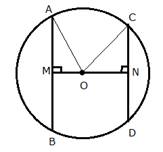
Given: A circle with centre O and radius r. ![]() . Also AB > CD
. Also AB > CD
To prove: OM < ON
Proof: Join OA and OC.
In Rt.![]()

Again in Rt. ![]()

From (i) and (ii)

Hence, AB is nearer to the centre than CD.
Solution 3
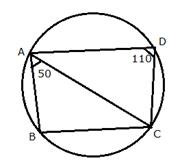
ABCD is a cyclic quadrilateral in which AD||BC
![]()
(Sum of opposite angles of a quadrilateral)
![]()
Now in ![]()

Now in ![]()

Solution 4
Since ABCD is a cyclic quadrilateral, therefore, ![]() BCD +
BCD + ![]() BAD = 180
BAD = 180![]()
(since opposite angles of a cyclic quadrilateral are supplementary)
![]()
![]() BCD + 70
BCD + 70![]() = 180
= 180![]()
![]()
![]() BCD = 180
BCD = 180![]() - 70
- 70![]() = 110
= 110![]()
In ![]() BCD, we have,
BCD, we have,
![]() CBD +
CBD + ![]() BCD +
BCD + ![]() BDC = 180
BDC = 180![]()
![]() 30
30![]() + 110
+ 110![]() +
+ ![]() BDC = 180
BDC = 180![]()
![]()
![]() BDC = 180
BDC = 180![]() - 140
- 140![]()
![]()
![]() BDC = 40
BDC = 40![]()
Solution 5
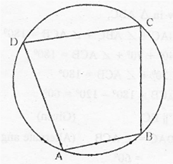
ABCD is a cyclic quadrilateral.


Similarly,


Hence, ![]()
Solution 6

Join AD.
AB is the diameter.
![]() ADB = 90º (Angle in a semi-circle)
ADB = 90º (Angle in a semi-circle)
But, ![]() ADB +
ADB + ![]() ADC = 180º (linear pair)
ADC = 180º (linear pair)
![]()
![]() ADC = 90º
ADC = 90º
In ![]() ABD and
ABD and ![]() ACD,
ACD,
![]() ADB =
ADB = ![]() ADC (each 90º)
ADC (each 90º)
AB = AC (Given)
AD = AD (Common)
![]()
![]() ABD
ABD ![]()
![]() ACD (RHS congruence criterion)
ACD (RHS congruence criterion)
![]() BD = DC (C.P.C.T)
BD = DC (C.P.C.T)
Hence, the circle bisects base BC at D.
Solution 7
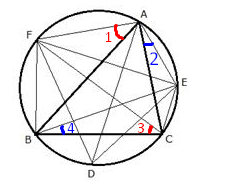
Join ED, EF and DF. Also join BF, FA, AE and EC.
![]()
![]()
In cyclic quadrilateral AFBE,
![]() (Sum of opposite angles)
(Sum of opposite angles)
Similarly in cyclic quadrilateral CEAF,
![]()
Adding (ii) and (iii)

![]()


Solution 8
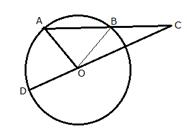
Join OB.
BC = OD ... (given)
OD = OB ... (radii of the same circle)
Hence,
BC = OB
In ![]()

In ![]()

Since DOC is a straight-line

Solution 9

Join AP and BP.
Since TPS is a tangent and PA is the chord of the circle.
![]() (angles in alternate segments)
(angles in alternate segments)
But
arc PA = arc PB,
hence PA = PB
![]()
But these are alternate angles
![]()
Solution 10
i) PQ is tangent and CD is a chord
![]() (angles in the alternate segment)
(angles in the alternate segment)
![]()
ii)

iii) In ![]()

Solution 11

Join OC.
BCD is the tangent and OC is the radius.

Substituting in (i)
![]()
Solution 12
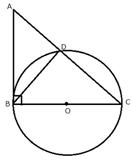
i) In ![]()
![]() and BC is the diameter of the circle.
and BC is the diameter of the circle.
Therefore, AB is the tangent to the circle at B.
Now, AB is tangent and ADC is the secant
![]()
Now,
∠BDC = ∠BDA = 90o ... angle subtended by a diameter
ii) In ![]()

From (i) and (ii)
![]()
Now in ![]()

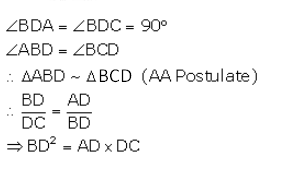
Solution 13
In ![]()
![]() (angles in the same segment)
(angles in the same segment)
AC = AE (Given)
![]() (Common)
(Common)
![]() (ASA Postulate)
(ASA Postulate)
![]() AB = AD
AB = AD
but AC = AE
![]()
In ![]()
![]() (angles in the same segment)
(angles in the same segment)
BC = DE
![]() (angles in the same segment)
(angles in the same segment)
![]() (ASA Postulate)
(ASA Postulate)
![]() BP = DP and CP = PE (cpct)
BP = DP and CP = PE (cpct)
Solution 14
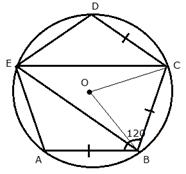
i) Join OC and OB.
AB = BC = CD and ![]()
OA = OD = OC = OB all are radii of the circle
Hence,
All the 3 triangles are congruent
So,
∠AOB = ∠DOC = ∠COB [By C.P.C.T.C]
OB and OC are the bisectors of ![]() and
and ![]() respectively.
respectively.
![]()
In ![]()

Hence,
∠AOB = ∠DOC = ∠COB = 60o
Arc BC subtends ![]() at the centre and
at the centre and ![]() at the remaining part of the circle.
at the remaining part of the circle.
![]()
ii)
Similarly,
∠BED = 0.5 ∠BOD = 60o
Solution 15
In the given fig, O is the centre of the circle and CA and CB are the tangents to the circle from C. Also, ![]() ACO = 30
ACO = 30![]()
P is any point on the circle. P and PB are joined.
To find: (i) ![]()
(ii) ![]()
(iii)![]()
Proof:

Solution 16
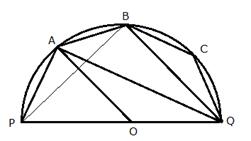
Join PB.
i) In cyclic quadrilateral PBCQ,

Now in ![]()

In cyclic quadrilateral PQBA,

ii) Now in ![]()

![]()
iii) Arc AQ subtends ![]() at the centre and
at the centre and ![]() APQ at the remaining part of the circle.
APQ at the remaining part of the circle.
We have,
![]()
From (1), (2) and (3), we have
![]()
![]()
Now in ![]()

But these are alternate angles.
Hence, AO is parallel to BQ.
Solution 17
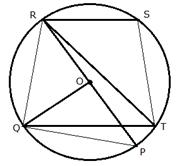
Join PQ, RQ and ST.
i)

Arc RQ subtends ![]() at the centre and
at the centre and ![]() QTR at the remaining part of the circle.
QTR at the remaining part of the circle.

ii) Arc QP subtends ![]() at the centre and
at the centre and ![]() QRP at the remaining part of the circle.
QRP at the remaining part of the circle.

iii) RS || QT

iv) Since RSTQ is a cyclic quadrilateral
![]() (sum of opposite angles)
(sum of opposite angles)

Solution 18
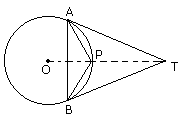
Join PB.
In ![]() TAP and
TAP and ![]() TBP,
TBP,
TA = TB (tangents segments from an external points are equal in length)
Also, ![]() ATP =
ATP = ![]() BTP. (since OT is equally inclined with TA and TB) TP = TP (common)
BTP. (since OT is equally inclined with TA and TB) TP = TP (common)
![]()
![]() TAP
TAP ![]()
![]() TBP (by SAS criterion of congruency)
TBP (by SAS criterion of congruency)
![]()
![]() TAP =
TAP = ![]() TBP (corresponding parts of congruent triangles are equal)
TBP (corresponding parts of congruent triangles are equal)
But ![]() TBP =
TBP = ![]() BAP (angles in alternate segments)
BAP (angles in alternate segments)
Therefore, ![]() TAP =
TAP = ![]() BAP.
BAP.
Hence, AP bisects ![]() TAB.
TAB.
Solution 19
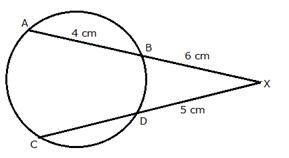
We know that XB.XA = XD.XC
Or, XB.(XB + BA) = XD.(XD + CD)
Or, 6(6 + 4) = 5(5 + CD)
Or, 60 = 5(5 + CD)
Or, 5 + CD = ![]() = 12
= 12
Or, CD = 12 - 5 = 7 cm.
Solution 20
From the figure we see that BQ = BR = 27 cm (since length of the tangent segments from an
external point are equal)
As BC = 38 cm
![]() CR = CB - BR = 38 - 27
CR = CB - BR = 38 - 27
= 11 cm
Again,
CR = CS = 11cm (length of tangent segments from an external point are equal)
Now, as DC = 25 cm
![]() DS = DC - SC
DS = DC - SC
= 25 -11
= 14 cm
Now, in quadrilateral DSOP,
![]() PDS = 90
PDS = 90![]() (given)
(given)
![]() OSD = 90
OSD = 90![]() ,
, ![]() OPD = 90
OPD = 90![]() (since tangent is perpendicular to the
(since tangent is perpendicular to the
radius through the point of contact)
![]() DSOP is a parallelogram
DSOP is a parallelogram
![]() OP||SD and
OP||SD and ![]() PD||OS
PD||OS
Now, as OP = OS (radii of the same circle)
![]() OPDS is a square.
OPDS is a square. ![]() DS = OP = 14cm
DS = OP = 14cm
![]() radius of the circle = 14 cm
radius of the circle = 14 cm
Solution 21
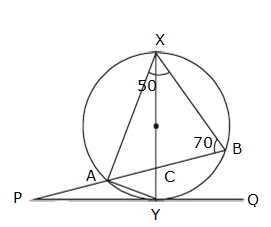
In ![]() AXB,
AXB,
![]() XAB +
XAB + ![]() AXB +
AXB + ![]() ABX=180
ABX=180![]() [Triangle property]
[Triangle property]
![]()
![]() XAB + 50
XAB + 50![]() + 70
+ 70![]() = 180
= 180![]()
![]()
![]() XAB=180
XAB=180![]() - 120
- 120![]() = 60
= 60![]()
![]()
![]() XAY=90
XAY=90![]() [Angle of semi-circle]
[Angle of semi-circle]
![]()
![]() BAY=
BAY=![]() XAY -
XAY -![]() XAB = 90
XAB = 90![]() - 60
- 60![]() = 30
= 30![]()
and ![]() BXY =
BXY = ![]() BAY = 30
BAY = 30![]() [Angle of same segment]
[Angle of same segment]
![]()
![]() ACX =
ACX = ![]() BXY +
BXY + ![]() ABX [External angle = Sum of two interior angles]
ABX [External angle = Sum of two interior angles]
= 30![]() + 70
+ 70![]()
= 100![]()
also,
![]() XYP=90
XYP=90![]() [Diameter ⊥ tangent]
[Diameter ⊥ tangent]
![]() APY =
APY = ![]() ACX -
ACX -![]() CYP
CYP
![]() APY=100
APY=100![]() - 90
- 90![]()
![]() APY=10
APY=10![]()
Solution 22
PAQ is a tangent and AB is a chord of the circle.
i) ![]() (angles in alternate segment)
(angles in alternate segment)
ii) In ![]()
![]()
iii) ![]() (angles in the same segment)
(angles in the same segment)
Now in ![]()
![]()
iv) PAQ is the tangent and AD is chord

Solution 23
i) AB is the diameter of the circle.
![]()
In ![]()

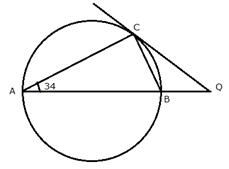
ii) QC is tangent to the circle
![]()
The angle between tangent and chord = angle in the alternate segment
![]()
ABQ is a straight-line

In ΔCBQ

Solution 24
i)

![]()
ii) Since, BPDO is a quadrilateral,

Solution 25
i) PQ = RQ
![]() (opposite angles of equal sides of a triangle)
(opposite angles of equal sides of a triangle)

Now, ![]() QOP = 2
QOP = 2![]() PRQ (angle at the centre is double)
PRQ (angle at the centre is double)
![]()
ii) ![]() PQC =
PQC = ![]() PRQ (angles in alternate segments are equal)
PRQ (angles in alternate segments are equal)
![]() QPC =
QPC = ![]() PRQ (angles in alternate segments)
PRQ (angles in alternate segments)

Solution 26
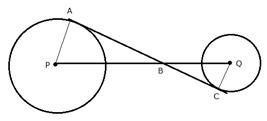
Since AC is tangent to the circle with center P at point A.
![]()
In ![]()
Also in Rt.![]()

From (i) and (ii),

Solution 27
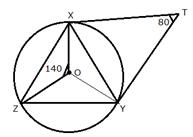
In the figure, a circle with centre O, is the circumcircle of triangle XYZ.
![]()
Tangents at X and Y intersect at point T, such that ![]() XTY = 80o
XTY = 80o
Since a tangent at any point of a circle is perpendicular to the radius at the point of contact,
we have ∠OXT = ∠OYT = 90o
So in quadrilateral XOYT
Sum of angles of a quadrilateral is 360 degrees,
∠XOY = 360 − (90 + 90 + 80)

Solution 28
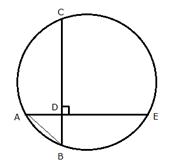
From Rt. ![]()
![]()
Now, since the two chords AE and BC intersect at D,
AD x DE = CD x DB
3 x DE = 9 x 4
![]()
Hence, AE = AD + DE = (3 + 12) = 15 cm
Solution 29

Solution 30


